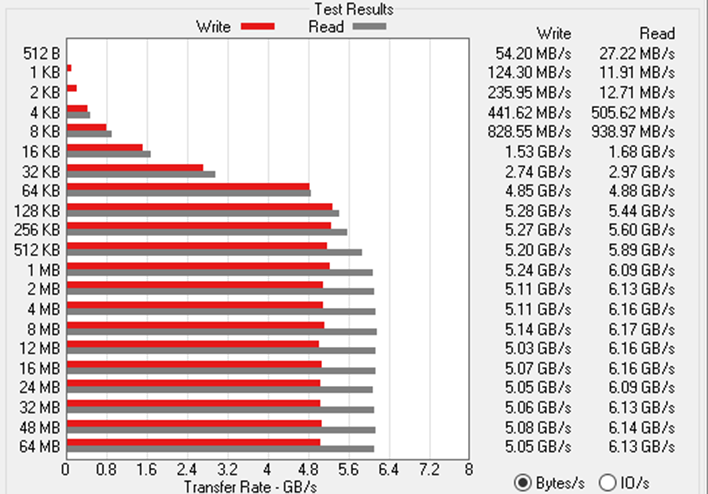We tested Falcon Northwest's Talon as it shipped from the company to ensure we get the same out-of-box experience as your average gamer, with the latest Windows updates installed. Many variables can affect performance, so our comparisons should serve as a reference point. Our benchmarking kicks off with storage, CPU, and game-scaling tests to get an idea how the Vybe performs in everyday use and how well performance scales across different resolutions.
 |
ATTO Disk Benchmark
|
Peak Sequential Storage Throughput
|
|
Running ATTO allows us to gauge the speed of the storage drive in the Talon. The primary storage on this configuration is dual 1TB Samsung
M.2 NVMe solid state drive. Unlike SATA-based SSDs, NVMe drives shuttle data through the PCIe bus for potentially must faster read and write performance. This particular drive is rated to deliver up to 1,800MB/s of sequential reads and writes.

The Talon we were sent came with dual M.2 drives setup in a RAID array. In our testing the drives were fast... extremely fast. With the largest transfer sizes, the storage setup was able to transfer files at over 6GB/s. That's fast enough for any workload, now or for the foreseeable future.
 |
Cinebench R20
|
3D Rendering On The CPU And GPU
|
|
Cinebench tests the CPU and GPU independently and provides a glimpse into the system's throughput. The test is based on Maxon’s Cinema 4D modeling software that’s used in movie production studios.

This is what happens when a benchmark is able to utilize all the available cores. In Cinebench the Talon was really able to showcase what a 24-threaded system can do. The single-threaded performance was slightly below that of the Intel Core i9-9900K, but the multi-threaded performance was strong.
 |
Geekbench 4
|
Single and multi-core
|
|
Geekbench 4 is a cross-platform benchmark that simulates real world processing workloads in image processing and particle physics scenarios. We tested the HP Obelisk in Geekbench 4’s single and multi-core test workloads.

Geekbench is another benchmark that is able to really utilize all available cores. So, once again we see the Talon coming out on top when it comes to multi-threaded performance, while it falls a little short to the single-performance of the Core i9-9900K processor.
 |
PCMark 10
|
Productivity and System-Level Benchmarking
|
|
UL Benchmarks' suite of tests have been the go-to system benchmarks since the late ‘90s. We ran the 20th Anniversary Talon through PCMark 10, which is designed to gauge the system performance in everyday use case scenarios with GPU acceleration-enabled, while 3DMark tests its gaming chops.

The 20th anniversary Talon is an a beastly system and more than capable of pulling its own weight while running spread sheets, or under any typical consumer workload. While the Talon wasn't the fastest computer we've tested using this benchmark it was nipping at the heals of the Intel Core i9-9900K based
Maingear Vybe.










